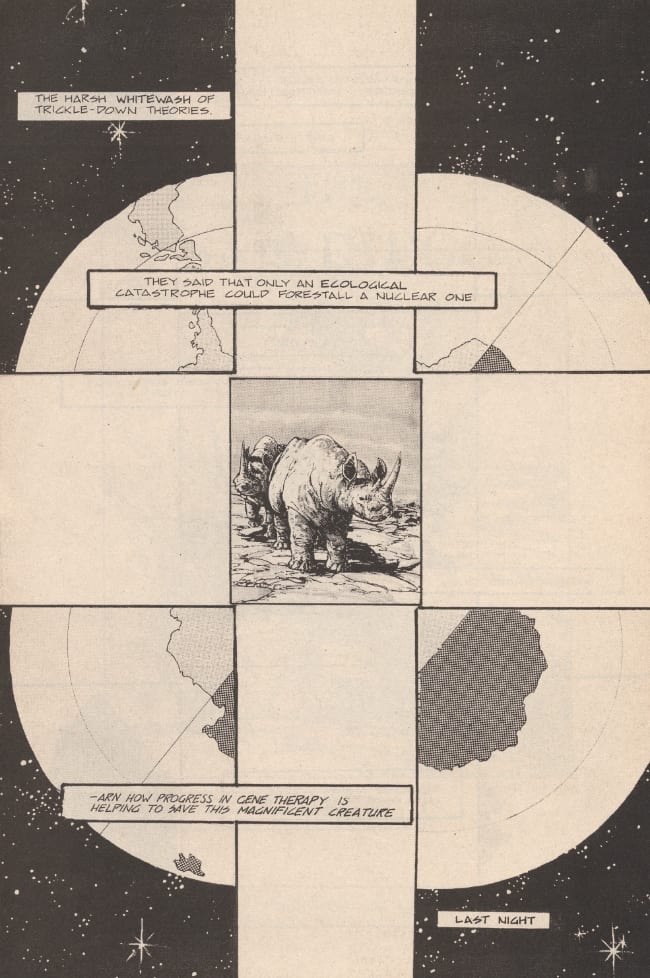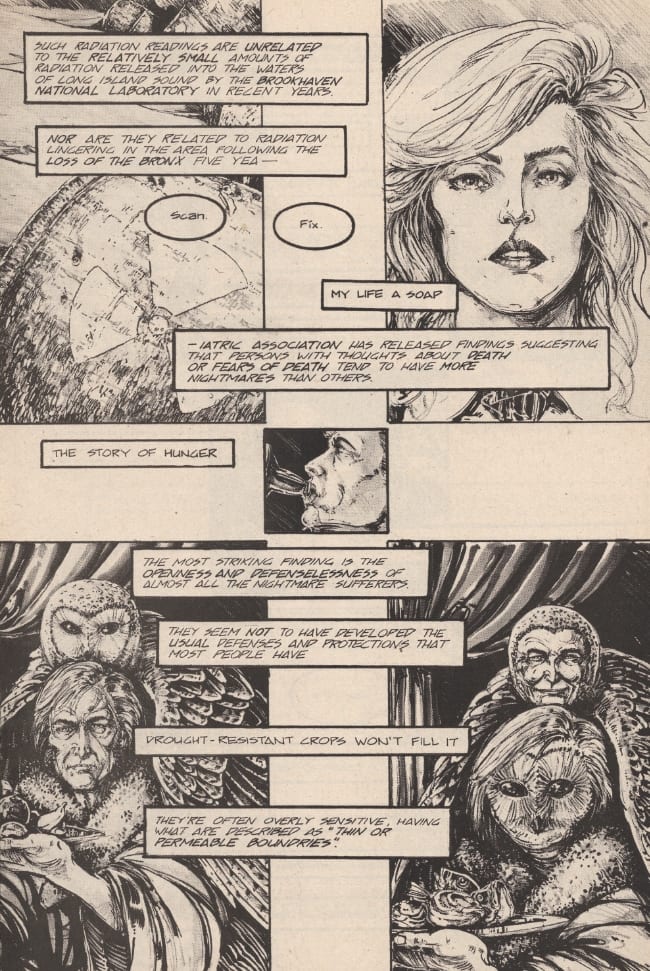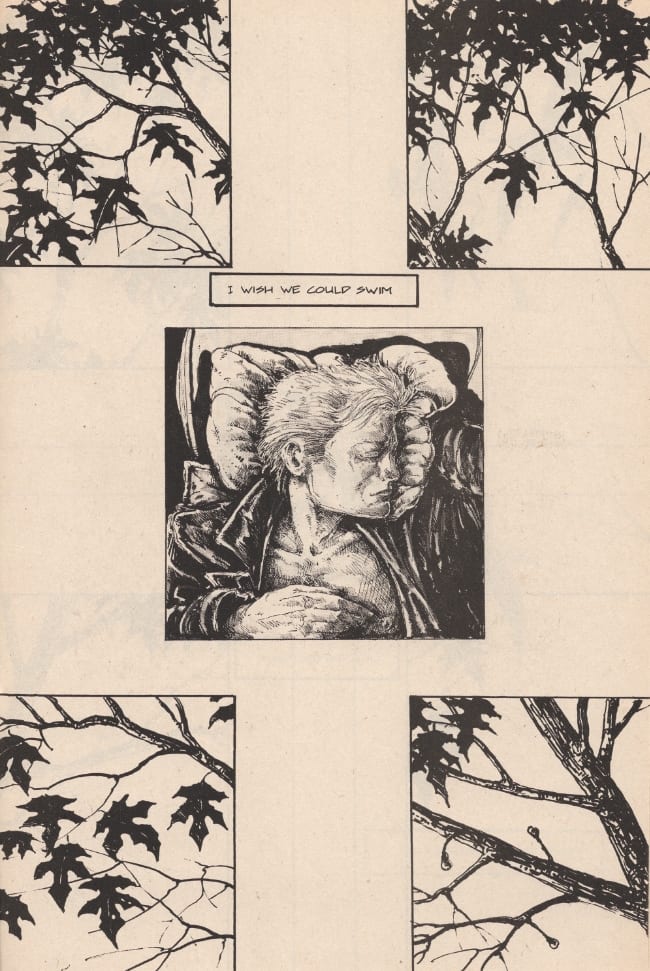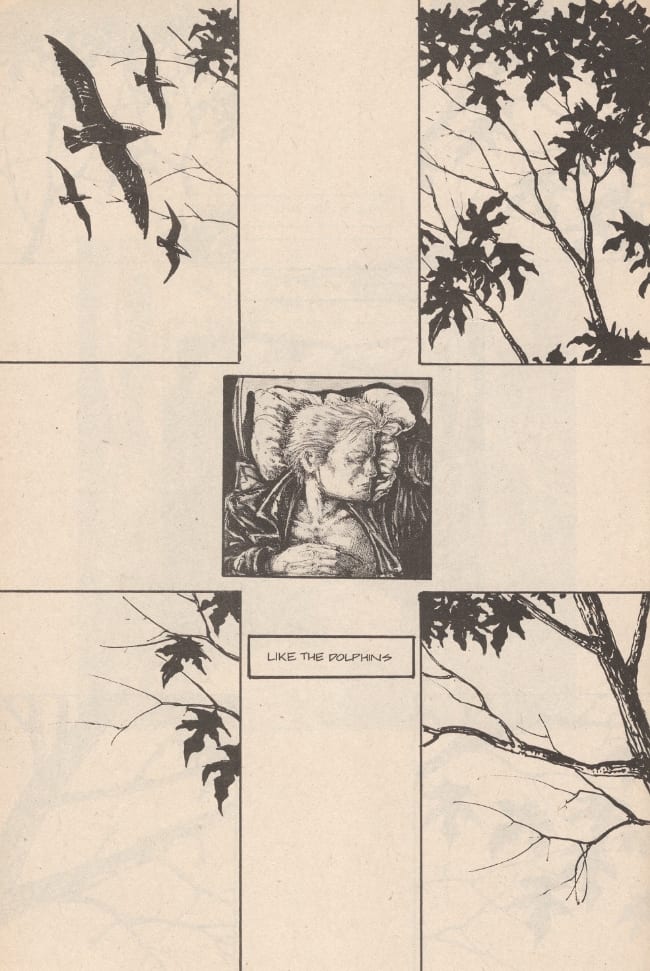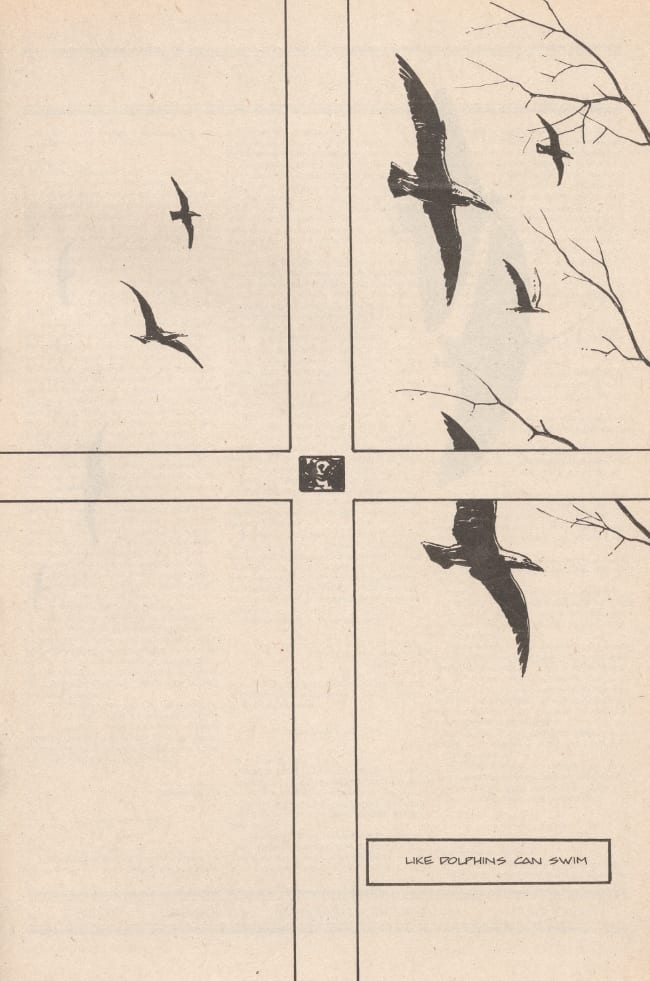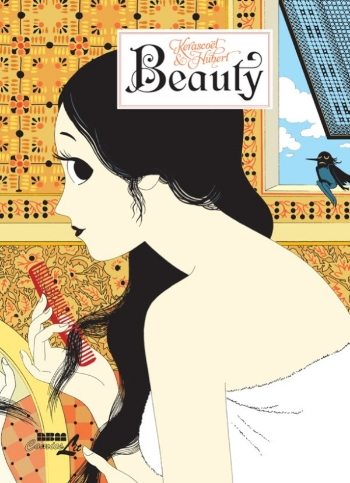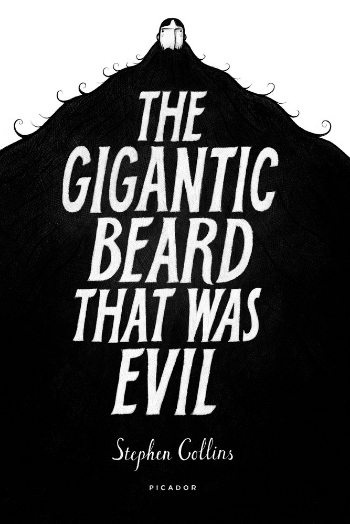I doubt there's very many of you who didn't hear yesterday that Twin Peaks is coming back to television in 2016, but fuck that noise - I was already high on an announcement you may have missed. A confirmation, really: made by no less an authority than Dave Sim, who has apparently been retained to write an introduction for a new Dover Publications reissue/continuation of The Puma Blues, a 23 1/2-issue series (1986-88) from writer Stephen Murphy and artist Michael Zulli which Sim had initially financed through a company of his, Aardvark One International. This ultimately led to a distribution contretemps, after Sim -- who had found some success in selling collected editions of his own series, Cerebus, directly to readers via mail order -- elected to withdraw an upcoming printing of a collected edition for the "High Society" storyline from distribution via Diamond (or any Direct Market-servicing distributor) due to low advance orders. In response, a national account representative for Diamond suggested that the distributor, invoking its own privilege to choose what to carry, would no longer distribute The Puma Blues, an action which would result in a 1/3 circulation drop for the series.
As it happened, Diamond never did drop The Puma Blues, although the incident did inspire a special 1988 "benefit" issue - more a show of creator solidarity that economic stimulus, which featured publication of "A Manifesto for Creators" (a predecessor to the Creator's Bill of Rights from later that year) and a number of collaborative or solo comics, including pages from Chester Brown, Tom Sutton, Dave Roman, Tim Truman, and Kevin Eastman & Peter Laird, whose Mirage Studios would subsequently become the series' final publisher. The best stuff in the benefit issue, though -- specifically, The Puma Blues #20 -- involves the famous team behind The Saga of the Swamp Thing. Alan Moore & Stephen R. Bissette (with inks by Zulli) provide a terrific four-page reflection on the angst of intimacy in a threatening world told from the point of view of a young man jerking off to mutant flying rays mating over a toxic lake, while Murphy (a comic store employee who'd written and drawn an earlier iteration of the series as student work) scripts a nice Zulli-pencilled, Bissette-inked horror short about a domesticated dog rediscovering its killer instinct in the midst of a happy family's home. Or at least, that's the climax.
The Puma Blues, you see, was never one for traditional narrative build and release. Superficially, it is comparable to the post-Swamp Thing Suggested for Mature Readers wing of DC, insofar as Murphy was, at that time, a fairly verbose writer in the Moore vein, and early issues of the series adopted a skewed genre comic's perspective on a near-future world kissed by terrorist assault (on NYC, uh-oh!) and the threat of ecological ruin. But that's not what's interesting about the series - unlike the proto-Vertigo comics, which were beholden to editors and preexisting characters and audience expectations, The Puma Blues was free to drift away entirely from the burdens of plot and spend issue after issue dreamily exploring how comics might convey the despair of being lonely and worried in the wild. It is a portrait of two green creators -- this was Zulli's first published comics work too -- seeing what they could do at a very specific moment in time that allowed a certain amount of visibility and economic comfort for such stumblings: the series had a five-figure readership, and only ended when Murphy found, by his own admission, that he was no longer at a place in his life where he felt he could access the series' glum and isolated tone. He subsequently wrote a huge number of Teenage Mutant Ninja Turtles comics (often under the pseudonym "Dean Clarrain"), as well as the 2006 Image series Umbra and a 2010-14 webcomic, Contains Traces Of, which he also drew.
Nonetheless: now the series is set to return, apparently with some sort of new conclusion, although *I* wonder if it's not just a conclusion to the series' third storyline, "Under a Deep Blue Sun", which was close to being finished when the series stopped, although the series as a whole never seemed anywhere near a definitive ending - I think I recall Zulli estimating that they were about a third of the way through, which (amusingly) would put the series' total length at the classic Vertigo series length of 60 to 75 issues.
There haven't been many Vertigo comics looking like this, though - not even the ones Zulli himself would later draw. All of the images in this post have been scanned from my personal favorite issue of The Puma Blues, #18. It is characteristic of the series, in that it is flawed and difficult and ambitious, but cumulatively it has an impact greater than most issues. Titled "Thin Skin", the comic is comprised of what are effectively full-page images, although the way the images are subdivided suggests four-panel grids. What happens is this: the issue begins with an image of the Earth, with subsequent pages seeing cuts forming horizontally and vertically on the page - gutters, though I see them as sutures. Gradually, the sutures give way and the gutters expand, and a new, central image emerges from the center of the page. Then, when the central image is large enough, similar gutters form on it, and we continue to dive deeper, deeper into the organism, from (1) the Earth itself (see image 1 above) to (2) the televisual media atmosphere (see image 2 above) to (3) a leering image of the saddened, drunken protagonist of the comic, the man Murphy could no longer identify with (just above). Text swarms like flies, italicized captions representing media narration while other captions capture the allusive, stream-of-consciousness thoughts of the reclining, booze-addled narrator/protagonist, lamenting the state of a dying world accessible only in montage.
And then, miraculously, we begin to pull back, as the man falls asleep. The captions vanish. We are back in the atmosphere, but instead of a media canopy it is the Natural World, full of the relief of white space on the page. Yet the man, searching for something to say, still at the mercy of narratives, can only quote Bowie & Eno. A mutant ray swoops by on the final, uncut page. This is all one organism, it says; every element of the page affects another.
***
PLEASE NOTE: What follows is not a series of capsule reviews but an annotated selection of items listed by Diamond Comic Distributors for release to comic book retailers in North America on the particular Wednesday identified in the column title above. Be aware that some of these comics may be published by Fantagraphics Books, the entity which also administers the posting of this column. Not every listed item will necessarily arrive at every comic book retailer, in that some items may be delayed and ordered quantities will vary. I have in all likelihood not read any of the comics listed below, in that they are not yet released as of the writing of this column, nor will I necessarily read or purchase every item identified; THIS WEEK IN COMICS! reflects only what I find to be potentially interesting.
***
SPOTLIGHT PICKS!
Beauty: Oh gosh, ha ha - this is the moment for this, right? Kerascoët is the collective name for French comics duo Marie Pommepuy & Sébastien Cosset, and they are the prime movers behind maybe *the* big tent consensus favorite among North American comics this year, Drawn and Quarterly's English-language release of Beautiful Darkness, a 2009 album drawn by the pair from an original story by Pommepuy, with Fabien Vehlmann brought aboard to script - clearly its fabulist portrait of warring and interdependent psychological capacities in the form of cute little elves murdering each other struck a nerve. Now comes a newer fancy, an all-in-one NBM hardcover edition of a 2011-13 series written by Hubert Boulard, in which a fairy grants a young woman the boon of peerless physical attraction, thus throwing her life into cataclysmic disarray. Folks were jonesing for this at SPX. It's 8.5" x 11" and 144 pages. Preview; $27.99.
The Gigantic Beard That Was Evil: I first heard of this one a little over a year ago, when it won the first 9th Art Award at the Edinburgh International Book Festival, prevailing over contemporaneous critical darlings like Chris Ware's Building Stories and Glyn Dillon's The Nao of Brown. The author is Stephen Collins, an illustrator and cartoonist for The Guardian and other venues; it appears to be a whimsical and allegorical story about a nearly bald man on a tidy island accosted by an unruly wave of bristles. Macmillan is the North American publisher, 240 pages at 6.13" x 8.84". Samples; $20.00.
--
PLUS!
In A Glass Grotesquely: The 136-page new one from Richard Sala and Fantagraphics, titled as a story selection but dominated by a color account of a master villain's activities which the artist initially released as a webcomic. Three other stories are included in this 7" x 7" softcover. Preview; $19.99.
Happy Stories About Well-Adjusted People: Also on the topic of alt-comics veterans, here is a Joe Ollmann story collection from Conundrum Press - actually "the definitive collection," in the publisher's words, compiling works from Chewing on Tinfoil (2001) and This Will All End in Tears (2006), with a pair of new stories and an introduction by Jeet Heer, all in 260 pages. Samples; $20.00.
Fish (&) Marx: Two from Nobrow. Bianca Bagnarelli is the author of Fish, and actually the founder of her own small-press comics outfit, Bologna's Delebile (I recommend the bilingual 2013 anthology Mother, and look forward to the imminent release of its follow-up, Work); it's a 6.7" x 9", 24-page comic about a boy fascinated with death. Marx is an English edition of a 2013 Corinne Maier/Anne Simon biographical BD collaboration, tracking the life of Karl across 72 pages. Nobrow also carries the duo's Freud. Fish preview, Marx preview; $11.00 (Fish), $19.95 (Marx).
Battling Boy: The Rise of Aurora West: The 160-page second chapter in creator Paul Pope's Battling Boy saga with First Second, although this is actually a prequel involving the series' heroine, the daughter of a famous superhero family. Note that Pope co-writes this one with J.T. Petty, while David Rubin handles the art (apparently in b&w, which I'd kind of like to have seen from Pope himself in the first one); the Battling Boy series proper will remain a Pope solo project, although at least one more of these Aurora West books is also planned. Preview; $9.99.
Blacksad: Amarillo: The 72-page fifth installment of Juan Díaz Canales's & Juanjo Guarnido's ultra-lush anthropomorphic critter detective series, maybe the most reliably-anticipated Eurocomics line available in English today (and the 'furry' comic nobody hesitates to buy). Dark Horse remains the publisher, as the title feline attempts to drive a client's classic car across the United States, only to run into the necessary amount of trouble for a compelling comics album to ensue. It's an 8 3/8" x 10 7/8" hardcover, with an introduction by Neal Adams. Preview; $17.99.
Miss Don't Touch Me: The Complete Story: This is another 8.5" x 11" NBM hardcover release of Kerascoët/Hubert stuff - catalog material now crammed into a 192-page omnibus for EZ impulse buying. Dating from 2006-09, the story follows a maid gone undercover in a brothel to catch the killer of her sister and other women. I'm told it starts very fizzy and ooh la la, but goes plenty dark in the back half. For the record, NBM has also released the entirety of Kerascoët's contributions to the Lewis Trondheim/Joann Sfar-created Dungeon franchise (as 2010's Dungeon: Twilight Vol. 3: The New Centurions), so their only comics works awaiting translation are a 2003 biographical comic, Anita O'Day, a 2014 kids' comic series, Les Tchouks (written by Benjamin Richard), and Voyage en Satanie, a 2011 reunion with Fabien Vehlmann that was cancelled after the first of an intended two volumes due to low sales. Marie Pommepuy also wrote a comic on her own in 2011, Cœur de glace, which was drawn by Patrick Pion, and looks like it taps into a dark fantasy vein VERY similar to Beautiful Darkness. Samples; $29.99.
Rabbids Vol. 1: BWAAAAAAAH (&) The Rage Vol. 1 (of 2): Zombie Generation: More French originals here, from two very different traditions. Rabbids is part of an enduring Ubisoft video game franchise, comprised of what looks to be a lot of short, none-too-wordy gag pages of lil' critters being anarchic and maybe fucking around with the comics form a little. The writer is a humor comics specialist, "Thitaume", and the artist is one Romain Pujol, neither of whom look to have been present in North American comic book stores prior to this; NBM/Papercutz publishes, 48 pages at 6" x 9". The Rage, on the other hand, is an adult-targeted horror thing about a zombie-ish virus affecting only children from Titan Comics' expanding line of translations; the creators, Pierre Boisserie & Malo Kerfriden, are fairly prolific mainline BD album guys who've been active for maybe 15 years each, again without anything I can recall in the way of English translation. This one's also 48 pages, at 8.5" x 11"; $7.99 (Rabbids in SC), $12.99 (Rabbids in HC), $9.99 (Rage).
Naruto Vol. 67 (&) World Trigger Vol. 1: But in recognition of the fact that everything can't *actually* continue forever -- despite the best intentions of big ticket shōnen magazine editors -- know that Masashi Kishimoto's ninja action franchise Naruto will purportedly conclude its 15-year run in the November 10 issue of Weekly Shōnen Jump. Not all of you will remember (or would have known in the first place), but there was a time back in the mid-'00s, when the bookstore manga boom was still hot, that Naruto was one of the most popular comics in North America. It's a little hard to determine, though, because the availability of the series in English also coincided with the first really big wave of easy access to manga and anime in unauthorized translation online - Naruto was always more of an anime phenomenon that bled into manga around here, and there were not a few fans that only ever pirated Naruto. In this way, while quite a cash cow still, its actual visibility was even higher than the money it made could indicate.
I'm a subscriber to VIZ's digital English version of Shōnen Jump, so I try to read Naruto sometimes. It's nearly incomprehensible to me: at least as difficult to grasp as any continuity-heavy superhero comic, though at the same time I can understand how its million-or-so characters and dense thatch of alliances and lore could transfix a dedicated audience for a long while. Personally, I respond better to Daisuke Ashihara's World Trigger, maybe because we're still in the 'growing complexity' stage of its formulaic young-people-making-friends-in-the-midst-of-an-interdimensional-monster-fighting-conflict scenario, but I also feel Ashihara's visual approach is much more agile and appealing than Kishimoto's in terms of really opening up those all-important combat sequences. Ha, we'll see how it looks in a decade and a half! Note that World Trigger is (already) up to vol. 8 in Japan, while Naruto is tipping the scales at 70; $9.99 (each).
Wonder Woman: The Complete Newspaper Strip 1943-1944: Your premiere reprint item among several from IDW this week, a slim 196-page tome -- at least, slim compared to some of their Library of American Comics behemoths -- collecting the entirety of a WWII-era Wonder Woman strip from the original (and very idiosyncratic) comic book team of William Moulton Marston & Harry G. Peter. That pretty much guarantees this book will be entertaining and possibly super-weird. An 11" x 8.5" landscape-format hardcover; $49.99.
The Last Temptation 20th Anniversary Hardcover: Also a reprint, this time from 1994-95 - not quite one the Michael Zulli Vertigo projects I mentioned above, but a Marvel Music joint: a Neil Gaiman-scripted companion to Alice Cooper's '94 album of the same title, but rightly suffused with Gaiman's own fascination with childhood and storytelling. It's from Dynamite now, 7" x 10.5" and 168 pages, set to include the complete scripts, some background correspondence, and Zulli's art in (full) color for what I think is the first time since the series' original serialization (or at least since Marvel has had the project); $39.99.
The Best American Comics 2014: And finally, here is your annual 400-page Houghton Mifflin Harcourt dispatch of the finest shorts 'n excerpts money can buy. This is the first year Bill Kartalopoulos is serving as series editor, which means he gathers up a big batch of potential entries through which the guest editor can select what is actually published. Hope I got that right! The guest editor this year is Scott McCloud, and from flpping through the book I can say they're definitely pursuing something a little more aggressive in style. Victor Cayro's in this! GERALD JABLONSKI! Main contents; $25.00.


